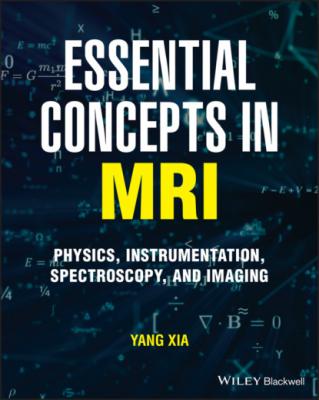Essential Concepts in MRI. Yang Xia
Читать онлайн.| Название | Essential Concepts in MRI |
|---|---|
| Автор произведения | Yang Xia |
| Жанр | Медицина |
| Серия | |
| Издательство | Медицина |
| Год выпуска | 0 |
| isbn | 9781119798248 |
Note that w0 can be considered as the probability of induced transitions, while the term ℏγB0/kBT can be considered as the probability of spontaneous transitions; their differences were distinguished first by Albert Einstein in 1916 when he published a paper on different processes occurring in the formation of an atomic spectral line in optical studies. And hence we can show that
where dn/dt goes to zero as n (a variable) goes to n∞ (a constant given by the population difference in the presence of B0 but in the absence of another rf field). If we define
and multiplying Eq. (3.33) with (1/2)γℏ, we can derive
which has been defined previously as Eq. (2.15a). Therefore, we can interpret T1 in terms of quantum transitions between the states.
The process of transverse relaxation may also be viewed as the result of quantum transitions. By defining the probability of transition between the states of operators Ix′ and Iy′ as w0x′ and w0y′, and recognizing at w0x′=w0y′=w0⊥, we can derive
where |M⊥|=(Mx′2+My′2)1/2. Hence,
3.7.2 Relaxation Mechanisms in the Random Field Model
More complicated explanation of relaxation mechanisms employs time-dependent Hamiltonians of the nuclear interactions. While in higher spin systems quadrupole interactions are significant, the dominant interaction in the spin-1/2 nuclei arises from the dipolar Hamiltonian, where the random field model of relaxation contains a very useful parameter (τc) that relates to the motional properties of the molecules. A full account of this model is too lengthy for this introductory book; here we quote some arguments and conclusions of this so-called Bloembergen–Purcell–Pound theory (BPP theory) [11].
The random field model of relaxation is simplified by restricting consideration to a pair of like spins under the influence of the dipolar interaction. The arguments for the spin-lattice relaxation in this model consider the fact that each spin is not completely isolated from the rest of the molecular ensemble (the lattice). There is an interaction between the spin and the lattice, due to the molecular motions, that enables the exchange of the thermal energy. Each nucleus is influenced by a number of nearby nuclei. These neighboring nuclei, in the same and other molecules, are in thermal motion with respect to the observed nucleus. This collection of motions gives rise to a fluctuating magnetic field, which disturbs the applied external field B0. Consequently, the magnetic moment will also experience the fluctuating local fields of its neighbors. Given the random nature for the motions of each molecule and of its neighbors, the motion would have a broad distribution of the frequencies. When the fluctuating local fields have components in the direction of B1 and at the precessing frequency ω0, these field components will induce transitions between energy levels, just like a purposefully applied B1 field.
The model defines a spectral density function Jq(ω), which is the Fourier transform of the auto-correlation function of the spatial tensor component q(t). Jq(ω) represents the relative intensity of the motional frequency ω. The auto-correlation function has some characteristic time τc where the function goes to zero when t ≫ τc. Hence, Jq(ω) has a characteristic frequency (τc-1), with which Jq(ω) goes to zero when ω ≫ τc-1. The correlation time τc is the characteristic time of the signal decay, which can be defined as the average time between molecular collisions for translational motion. The value of τc depends upon many factors of the sample, such as molecular size, molecular symmetry, and solution viscosity. For random molecular tumbling, τc corresponds approximately to the average time for a molecule to rotate through one radian. A shorter/longer τc corresponds to samples with more/less mobile molecules.
Figure 3.3 shows schematically the variations of the spectral density function Jq(ω) in three different cases. Since the area under each curve represents the total energy available for the motion, the area under any curve stays constant among the curves. If τc is long (case a in Figure 3.3), as in solids or viscous liquids, the low motional frequencies have a higher chance of occurring, and consequently Jq(ω) has weaker components at ω0. At the other extreme, if τc is short (case c in Figure 3.3), as in liquids of low viscosity, molecular motions are distributed over a wide frequency range, and all motional frequencies within that range have equally probable chance of occurring; however, no one component, in particular that at ω0, can be very intense. An optimum efficiency for thermal relaxation of the spins can be expected when Jq(ω) reaches a maximum at ω0, when ωτc ~ 1 (case b in Figure 3.3).
Figure 3.3 Schematic power spectra of the spectral density function Jq(ω), as the function of the frequency log(ω). (Case a) Specimens having high viscosities or rigid lattice have long τc (ω0 > 1/τc), which leads to weak Jq(ω) at ω0. (Case b) Specimens having intermediate viscosities have shorter τc (ω0 ~ 1/τc), which leads to a maximum Jq(ω) at ω0, hence optimum relaxation. (Case c) Specimens having low viscosities have short τc (ω0 < 1/τc), which leads to a broad spectrum of Jq(ω) with no component having a high value.
This model shows that the spin-lattice relaxation will depend on Jq(ω0), which has a line shape of a Lorentzian. We can also show that, by similar arguments or using the density operator formalism, the spin-spin relaxation will depend on Jq(0), because it involves no energy exchange. Figure 3.4 shows schematically the plots of relaxation times as the function of log(τc). On the left of the condition when ω0τc = 1, T1 is approximately
